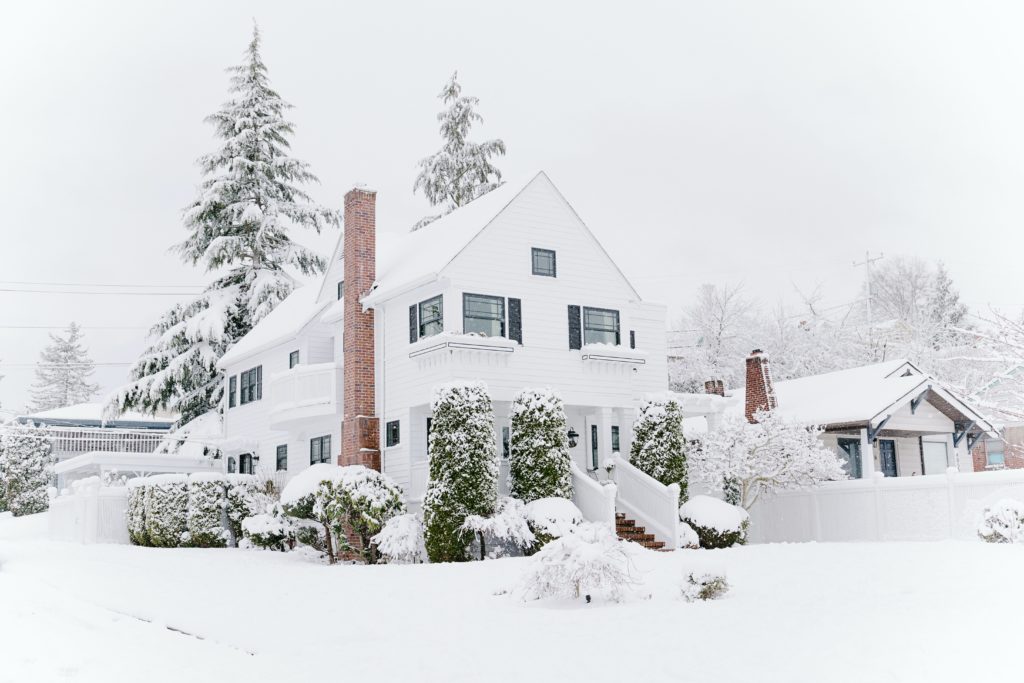Winter is right around the corner! That means it’s time to winterize your home to protect it against the elements, and prevent any problems that could happen, like flooding or fires.

Inside the home
Let’s start off with what you can do inside to winterize your house.
Preventing drafts
Drafts can be blocked with caulk or weather stripping, where appropriate. Blocking these areas is crucial to saving money on heating, and preventing insects and animals from getting into your home. So, check out these areas to see if you can feel any air flow, then block it accordingly.
- Windows
- Exterior doors
- Attic
- Basement
Care for your air
You should have your HVAC serviced twice a year during the fall and spring while the weather is typically more mild. Nothing is worse than losing central air during the dog days of summer or the dead of winter!
Additionally on the topic of air, clean or replace your air filters to ensure clean, proper flow. Include cleaning your hood exhaust and dryer lines on this list as well. Build up in these areas prevents air flow, and could even lead to fires.
Inspect all the water-related fixtures
To prevent pesky leaks and water damage, examine the following sinks, toilets, and shower fixtures for any leaks or signs of sealant decay. Replace or repair with caulk where necessary.
- All sinks
- All toilets
- Shower fixtures
- Pipes under cabinets or otherwise hidden.
If you have a sump pump, give a quick check to make sure the line going outside is clear of any debris, and that the pump is working properly to prevent flooding.
Electronics and other potential fire starters
Look at all electrical cords in the home, including any winter-specific devices such as space heaters, for damage (including damage from water) and replace when needed. Be sure to also check your outlets for any damage, and test ground fault circuit interrupters.
Have a wood-burning chimney? Make sure the flue and the damper are working. If you can’t remember the last time your chimney was cleaned, call a professional to come do the job. Chimneys are dangerous to clean yourself, and a dirty chimney is a fire hazard.
While you’re thinking about preventing fires, it’s a good time to change out the batteries in your smoke and CO2 detectors. If you have a fire extinguisher, make sure it hasn’t expired. Extinguishers are good for around ten years. Don’t have a fire extinguisher? You can get one from Amazon here.
Outside the home
While there are a lot of things to do inside, there are also some very important tasks to complete on the exterior of your home.
Seal, seal, seal
Just like inside, you’ll need to check for any places that might let water in or air out and seal or repair these spots. Look at window fixtures, doors, garage doors, and hose bibs for signs of a possible leak.
Caulk or re-caulk problem areas, be on the lookout for any damaged weather stripping, and replace it if needed. Even though you may have blocked interior drafts, it’s still possible for exterior sources of drafts to exist, so checking both sides is important.
Gutters and downspouts
Make sure your gutters and downspouts are clear and can redirect water properly, and also look for any damage. Clean and repair where necessary.
Furthermore, see that the drainage from your gutters is directed away from your house, at a downward angle to prevent flooding.
Roof inspection
While you’re checking out your gutters, see if there are any damaged shingles, signs of wood rot, and check the seals on your skylights, if you have them. It’s also a good idea to look at your chimney for any signs of damage.
If you feel uncomfortable on the roof or can’t inspect it for any reason, don’t hesitate to call a local roofer to look for you. Your safety is the most important factor, and a professional will be happy to assist you!
Check the wood and pipes
Looking at the exterior, repaint or replace any damaged areas, especially if there’s rot involved. If you have a deck or patio, inspect those areas as well to make sure they’re safe for use.
As for pipes, re-insulate any pipes coming in and out of your home if they need it, and turn off water going to external sources like hoses and sprinklers.
What are some things you do to prepare for the cold weather? Tell me about it in the comments!
Did you enjoy this content? Check out my other posts.


Leave a Reply